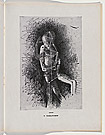Ode
Spectacle in three acts
- Producer: Les Ballets Russes de Serge Diaghilev
- Premiere: 6 June 1928, Théâtre Sarah Bernhardt, Paris
- Costume design: Pavel Tchelitchew and Pierre Charbonnier
- Costumier: A Youkine
- Scenery design: Pavel Tchelitchew and Pierre Charbonnier
- Music: Nikolai Nabokov
- Choreography: Léonide Massine
- Libretto: Boris Kochno, after Spiritual odes by Mikhail Lomonosov
- Main characters: Nature, the Pupil, constellations, stars, rivers
Nature, originally presented as a statue on a pedestal, comes to life and descends in answer to a student’s questions. He asks Nature to display her power over the constellations, the rivers, planets and humankind. However, after these displays the student is not satisfied and begs Nature for a glimpse of her festival—the Aurora Borealis. Mesmerised by the beauty and wonder of this display, the student attempts to enter the Aurora Borealis, only to destroy it. The ballet ends with Nature returning to her statue form.
Billed as ‘an evening meditation on the majesty of God on the occasion of an apparition of the Aurora Borealis’, this ballet is based on Mikhail Lomonosov’s eighteenth-century hymn of the same name dedicated to the Russian Empress Elizabeth. Diaghilev’s original brief for this ballet was that it be presented in the manner of an eighteenth-century court spectacular as homage to the empress, from whom he claimed he was descended. However, his commissioning of Tchelitchew, an innovative young artist who had studied with the stage designer Alexandra Exter, drove the design in the distinctly different direction of radical Constructivism. Tchelitchew’s stage design placed the dancers in formations among three-dimensional geometric delineations of the stage area formed by white cords, along which miniaturised puppet versions of the dancers were placed to simulate perspective. The costumes, crinoline-skirted dresses with mesh masks or fitted bodysuits in black, white, grey and blue gauzy fabrics, were appliquéd with geometric designs of mirrored paillettes or painted with phosphorescent paint in angular designs. The balletic action was set before a cinema screen on which projected moving images and rear-projected lighting provided a changing and visually dynamic spectacle for the audience. The overall effect was a celebration of the projected, reflected, diffused and sparkling qualities of light itself in a revolutionary piece of theatre design, although as a choreographic performance its rigidity did not endear it to audiences already used to the more dynamic entertainment they were seeing in movie theatres.





